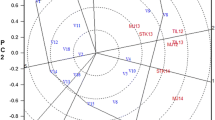Summary
Nine cowpea (Vigna unguiculata (L.) Walp.) breeding lines were grown in 13 experiments under sole crop and intercrop management, with and without insecticide application, in Nigeria. Cowpea was intercropped with cassava (Manihot esculenta Cranz), maize (Zea mays L.) and maize-cassava in the forest zone and with sorghum (Sorghum bicolor Moench.) and millet (Pennisetum glaucum (L.) R.Br.) in the savanna zone. Line by cropping system interactions were significant in 5 of 13 experiments and line by insecticide treatment interactions were significant in 2 of 13 experiments. Cowpea yield was severely depressed in intercropped plots and in plots to which no insecticide was applied. Among-environment variation in cowpea yield was greater when no insecticide was applied. Within each management treatment, the yield performance and stability of the cowpea lines was examined. Stability was assessed both by examining among-environment coefficients of variation and by regression analysis. Several of the breeding lines evaluated appeared promising under different levels of management and in a diversity of environments.
Similar content being viewed by others
References
Arnon, I., 1972. Crop Production in Dry Regions Volume II, Leonard Hill Ltd., London
Blair Rains, R., 1963. Grassland research in Northern Nigeria 1952–1962. Samaru Misc. Paper 1, Zaria.
Booker, R.E., 1965. A note on the effect of spacing on the incidence of Ootheca mutabilis (Satilb.). Samaru Misc. Paper No. 10.
Faris, M.A., M.R.A. de Araujo, M. de A. Lira & A.S.S. Arcovere, 1983. Yield stability of intercropping studies of sorghum or maize with cowpea or common beans under different fertility levels in northeastern Brazil. Can. J. Plant Sci. 63: 789–799.
Finlay, K.W. & G.N. Wilkinson, 1963. The analysis of adaptation in a plant-breeding program. Aust. J. Agric. Res. 14: 724–754.
Francis, C.A., 1985. Variety development for multiple cropping systems. CRC Crit. Rev. Plant Sci. 3: 133–168.
Francis, T. & L.W. Kannenberg, 1978. Yield stability studies in short-season maize. 1. A descriptive method for grouping genotypes. Can. J. Plant Sci. 58: 1029–1034.
Griffiths, J.F., 1972. Nigeria. In: H.E. Landesberg, (Ed.), World Survey of Climatology Vol. 10, Elsevier, New York.
Herrera, W.T. & R.R. Harwood, 1973. Crop interrelationship in intensive cropping systems (mimeographed). IRRI, Los Banos.
Huxley, P.A. & Z. Maingu, 1978. Use of a systematic spacing design as an aid to the study of intercropping: some general considerations. Expl. Agric. 14: 49–56.
Jackai, L.E.N., S.R. Singh, A.K. Raheja & F. Wiedjik, 1985. Recent trends in the control of cowpea pests in Africa. In: S.R. Singh & K.O. Rachie (Eds.), Cowpea: Research, Production and Utilization. John Wiley and Sons, Chichester.
King, J., 1984. Market index and dietary patterns of low-income households with special reference to cowpea. Nig. J. Nutr. Sci. 5: 1–10.
Lightfoot, C.W.F. & R.S. Tayler, 1987. Intercropping sorghum with cowpea in dryland farming systems in Botswana. II. Comparative stability of alternative cropping systems. Expl. Agric. 23: 435–442.
Lin, C.S., M.R. Binns & L.P. Lefkovitch, 1986. Stability analysis: where do we stand? Crop Sci. 26: 894–900.
Muleba, N. & H.C. Ezumah, 1985. Optimizing cultural practices for cowpea in Africa. In: S.R. Singh & K.O. Rachie (Eds.), Cowpea: Research, Production and Utilization. John Wiley and Sons, chichester.
Norman, D.W. 1974. Rationalizing mixed cropping under indigenous conditions: the example of northern Nigeria. J. Devel. Studies 11: 3–21.
Ntare, B.R. & M. Aken'Ova, 1985. Yield stability in segregating populations of cowpea. Crop Sci. 25: 208–211.
Ofori, F. & W.R. Stern, 1987. Cereal-legume intercropping systems. Adv. Agron. 41: 41–90.
Parker, K.E., 1988. The economic profitability and adoption of the improved cowpea package in Nigeria. RCMP Working Group, IITA, Ibadan.
Singh, S.R. & D.J. Allen, 1980. Pests, diseases, resistance and protection in cowpeas. In: R.J. Summerfield & A.H. Bunting (Eds.), Advances in Legume Science, Her Majesty's Stationary Office, London.
Author information
Authors and Affiliations
Rights and permissions
About this article
Cite this article
Blade, S.F., Mather, D.E., Singh, B.B. et al. Evaluation of yield stability of cowpea under sole and intercrop management in Nigeria. Euphytica 61, 193–201 (1991). https://doi.org/10.1007/BF00039658
Received:
Accepted:
Issue Date:
DOI: https://doi.org/10.1007/BF00039658




